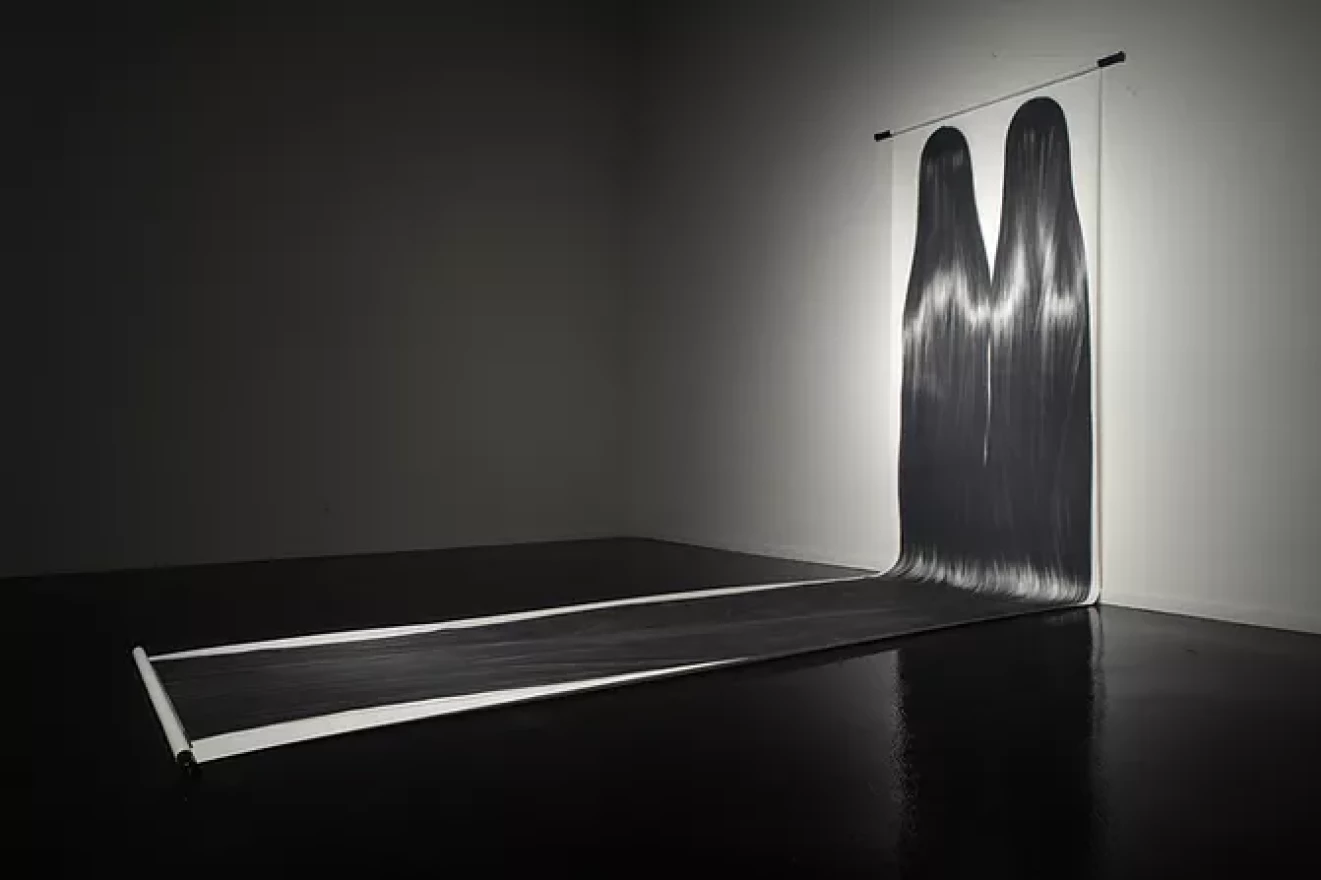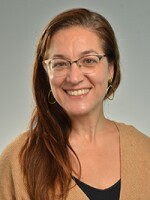For more stories like this one, subscribe to Real Humans on Apple Podcasts or Spotify.
Lawrence, Kansas, artist Hong Zhang is internationally known for her huge, arresting paintings of long, black hair. Neat black lines on rice-paper scrolls stretch from ceiling to floor in mesmerizing cascades. Where wall meets floor, the scrolls — and hair — unfurl, folding then stretching along the ground.
It's utterly beautiful, this hair that won't be contained.
But as Zhang moved from a polished professional studio to the intimacy and isolation of her own basement, absorbing news of Black Lives Matter protests and anti-Asian hate, the hair in her art got messier. Her paintings turned more crowded, more chaotic.
Zhang's new series created during and about the pandemic, is called "Encounters." It isn't about her — at least, not in the way her past work seemed to be. This series is about us: how we connect, and how we don't.
Long hair wraps around bodies, between almost-kissing couples, tying them together and keeping them apart. Human figures stand covered in hair, walled off in their own worlds at this increasingly-familiar six-foot interval.
Uncut hair wraps around necks and heads, covering faces like protective masks. It twists into a knotted styles, complicated up-dos and buns that raise like clenched fists. Errant strands blowing in invisible wind.

The neatness of line and clarity of meaning in Zhang's past work give way to clutter and confusion. When I look at these paintings, I see a story of the last year and a half, tying us uneasily together.
It begins with the routines and expectations that nudged us toward the orderly. We knew the rules, whether we followed them or not. We kept up appearances.
Then, like the figures tangled up in Zhang's paintings, we got caught up in our own worlds, so overwhelmed we couldn't see each other.
"'Encounters' is a series that expresses my desire and hope... for unification in a global pandemic," Zhang tells me. "I wanted to show my solidarity."
Zhang's art has always pushed against oppression.
As a student at China's top art school in Beijing, she pursued rigorous training in traditional ink painting techniques. Nothing else, just ink painting.
"You're only allowed to study in one single medium," explains Zhang. "Everybody's work looks similar, you know, in terms of subjects. All landscapes, flowers, birds, portraits of leaders."
At the time, Zhang says, Chinese artists advanced in their careers through state-run exhibitions. Veering from pre-determined subject matter or traditional styles was not allowed.

Zhang grew proficient — and restless. I ask her, more than 20 years later, what that felt like, and her manner changes. She looks me straight in the eye and blurts, without hesitation, "You feel trapped."
So when she left China for the United States in 1998, it was for her art.
"I didn't want to make exactly the safe type of work approved by the government," Zhang recalls. "I didn't know exactly what I wanted to make, but I knew that I wanted to make something different."
As a graduate student in California, Zhang's first painting was a portrait of her parents, who endured Mao Zedong's crackdown on intellectuals, posed against a wallpaper of the Chairman.
But where her parents' heads should be, Zhang instead sketched shoes: a soft black cotton shoe with a buckle for her mom, a stiff army shoe for her dad.
That painting, "My Parents Shoes," will be projected onto the side of a building in New York City on Friday, Sept. 10 as part of an international exhibit called "Dreamers." Works by 40 artists, all immigrants, will light up outdoor walls throughout the city.
The hair art that earned her worldwide acclaim is political in a different way. It's not about the policies that confined Zhang in her native country, but the subtler oppression she experiences in America.

In China, Zhang says, she didn't see herself as Asian.
"There's no difference to race," she says. "I started to notice racial difference after I came to America, but the first five years I still couldn't get it because I had never seen myself as, you know, a different race. If somebody hassled me or wasn't friendly toward me, I wouldn't take as a racial. I would question myself: 'Is it something I did wrong?'"
With long black hair standing in for her own identity, Zhang questioned what it means to be Chinese, something she'd never had to ask herself before. What connects her to her roots? What defines her? How do others perceive her?
Since the early 2000s, Zhang has maintained a professional studio in Lawrence, often welcoming collectors, curators, and scholars.
In March 2020, studio visits screeched to a halt. So did exhibits. Zhang retreated to the basement of her house, making art just for herself.
"I kind of used this quiet time, just focusing on my work," she says.

With "Encounters," Zhang wrestles with the messiness of mingling — especially now.
That's what excites her about the projection of her art in New York City, her first art exhibition since the pandemic began.
"It's on the street outdoors," Zhang explains. "So I thought, that's the best idea — to express ourselves stronger and louder and more diverse rather than just one single artist's work."
Once the projectors switch off in New York, Zhang hopes to try something like it closer to home, near Lawrence.
"I feel like I have a duty or tool," Zhang says. "I don't want to make the safe work like people know best in America."







